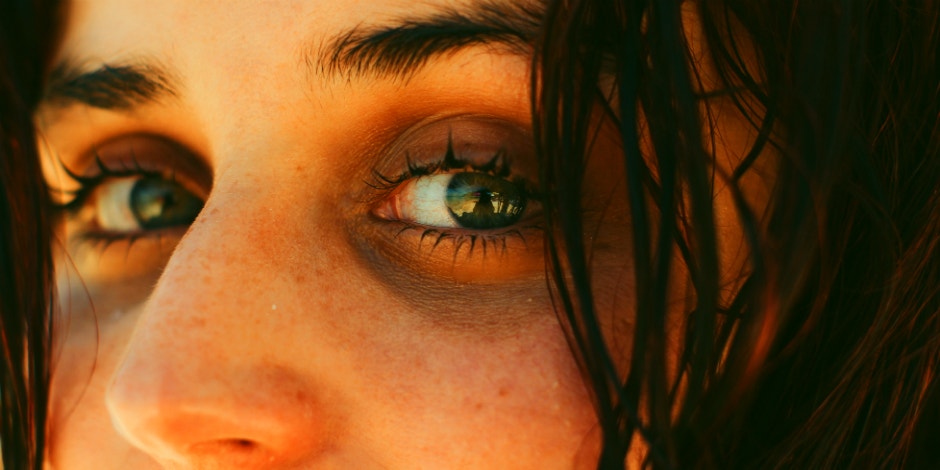What It Might Mean If You Have Bumps On Your Face
Always consult your dermatologist.
 getty
getty Think all bumps on your face are just pimples? Well, that's not necessarily true. Even if they are, pimples come in many forms, and have different causes and solutions, depending on the type of acne and where they come from.
When you're wondering how to get rid of bumps on your face, you may consider using certain cleansers or topical treatments. But sometimes, these aren't the correct solutions for your skincare. What exactly are those bumps on your face if they aren't related to acne?
“Bigger pimples would fall into the category of cysts," says cosmetic dermatologist Dr. Kenneth Mark. "Other bumps could be benign lesions such as moles or Keratoses. Insect bites could also cause bumps. Skin cancers, including basal and squamous cell carcinoma, can cause bumps on the face as well."
Whether you have an acne breakout, a skin irritation, or something more serious (like skin cancer), there are a lot of potential causes for those bumps.
1. Sebaceous Hyperplasia
These are flesh (or pinky-yellow)-colored, donut-shaped bumps that can develop on the forehead, cheeks, nose and chin.
"They are actually enlarged oil glands in the skin, and sometimes, you can even squeeze oil out of them. They are not caused by oily skin and they are not the cause of oily skin. They are inherited, so you can’t prevent them if you are genetically prone to them. There are no permanent treatments. However, your dermatologist can flatten them with electrocautery so they are not as apparent," says Tsippora Shainhouse, MD, FAAD, a board-certified dermatologist.
2. Fibrous Papules
There are skin-colored bumps that develop on the face, neck, and sometimes chest and arms. They look like small, non-inflamed pimples, but nothing comes out if you try to squeeze them. What are these fibrous papules?
"They are actually composed of skin cells and vessels. They are completely benign and do not require treatment. But if you hate them or find yourself picking, your dermatologist can remove or flatten them for you," Dr. Shainhouse says.
3. Periorificial Dermatitis
This is an acne-like eruption that tends to develop in women and children, and presents with persistent pink bumps around the facial openings (eyes, nose and mouth).
According to Dr. Shainhouse, "It can last for months or years, if not properly treated. It does not resolve with classic acne medications, and can be triggered or worsen with topical steroid use. If you have this condition, your dermatologist will prescribe topical and oral antibiotic and anti-inflammatory medications that will clear this breakout, but you will have to be patient, as it can take over a month to resolve."
4. Papular Eczema
While classic eczema presents with itchy, pink, scaly patches, some people develop a popular version that looks like crops of tiny pink bumps.
"When they develop on the face, they can look like tiny whiteheads or inflamed papules, but nothing comes out if you squeeze them. They will not respond to acne meds. If you do have persistent eczema patches, your dermatologist will treat you with a topical anti-inflammatory cream," Dr. Shainhouse advises.
5. Basal Cell Carcinoma
Unlike treatable skin conditions, basal cell carcinoma is slow-growing skin cancers that derive from the base layer of the epidermis. They are usually caused by excessive UV exposure, including sun and tanning lamps.
"They are common, and up to 1/5 Caucasian people in the US can expect to develop one over their lifetime. They look like shiny, translucent or pink bumps with tiny blood vessels. They often have a cycle of bleeding, then healing almost completely, then bleeding again, but they never heal up. They can be mistaken for a persistent/recurrent/picked acne cyst," warns Dr. Shainhouse.
“Basal Cell Carcinoma is the most common type of skin cancer with over 3 million diagnosed each year in the United States alone. The most common location is the nose, followed by the ear. The most typical example of a basal cell carcinoma is a pearly, shiny bump with blood vessels sprinkled throughout it to give it a reddish hue," agrees Dr. Mark.
6. Cysts
Cysts are red nodules that "typically start as clogged pores... they develop into pimples, then grow into super-large pimples that would be classified as a cyst," says Dr. Mark. Be sure to see your dermatologist, as most cysts can be removed through a medical procedure.
7. Moles
Having a mole sounds much worse than it actually is. Says Dr. Mark, “Benign lesions, such as moles or keratoses, are growths that are typically brown or sometimes skin-colored. They usually originate in the epidermis, meaning the top layer of the skin. Some moles could be considered birthmarks and others develop later in life."
8. Insect bites
We don't always think of our face as the most common location for an insect bite, but they do happen. "Insect bites are common and usually a pink- or red-colored bump," says Dr. Mark. You can treat these with topical creams to reduce itching.
9. Squamous Cell Carcinoma
“Squamous Cell Carcinoma is the second most common type of skin cancer, accounting for almost a million cases per year in the United States alone. Unlike Basal Cell Carcinoma, Squamous Cell Carcinoma tends to be hyperkeratotic lesions that appear thick, scaly and crusty," Dr. Mark advises. If you do have a lesion that just doesn’t heal after a month or two, see your dermatologist for evaluation.
Aly Walansky is a NY-based lifestyles writer. Her work appears in dozens of digital and print publications regularly. Visit her on Twitter or email her at alywalansky@gmail.com.

